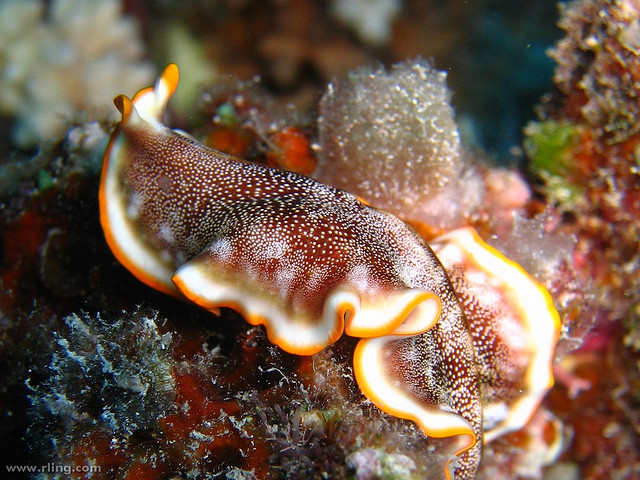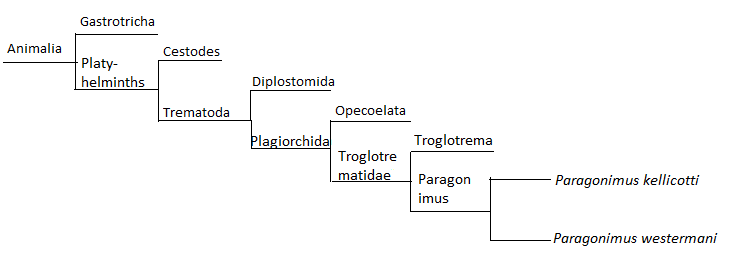Classification
In creating the taxonomy of Paragonimus
westermani, a morphological approach is almost always taken.
However, classification can be pretty tricky business, as the fluke
is not only closely related to other Paragonimus spp., but
there is also much variation within the P. westermani
species itself. Nonetheless, size and shape of the organism are
distinctions often made at the adult, metacercariae, and egg stages.
In addition, the quality and presence or absence of features typical
of a certain point in the life cycle (such as the size of the
ventral sucker in the adult stage, the presence of an inner cyst
wall at the metacercariae stage, etc.) are taken into consideration
(Sugiyama 2013).
That being said, the taxonomic classification for the human lung
fluke is as follows:
Domain: Eukarya
Kingdom: Animalia
Phylum: Platyhelminthes
Class: Trematoda
Subclass: Digenea
Superorder: Epitheliocystidia
Order: Plagiorchiida
Family: Troglotrematidae
Genus: Paragonimus
Species: Paragonimus westermani
Domain: Eukarya
Paragonimus westermani fits into the Eukarya domain, first
and foremost, because it possesses the membrane-bound organelles
that are lacking in the other (Bacteria and Archaea) domains. Other
characteristics that place the fluke here include lacking
peptidoglycan in its cell walls, possessing introns in its genes,
and lacking circular chromosomes (Campbell et al. 2008). All of your
stereotypical, macroscopic organisms fall into this category, as do
many microscopic critters (like the human lung fluke). Accordingly,
all plants (ex. the Christmas cactus,
Schlumbergera bridgesii), fungi (ex. the cow patty
mushroom,
Psilocybe cubensis), and animals are included here.
Kingdom: Animalia
The multicellular eukaryotes of the Eukarya domain are split into
three kingdoms primarily by how they acquire nutrients. As the
P. westermani first ingests and then digests its food, it belongs to
the Animalia kingdom (Campbell et all. 2008). Organisms included in
this kingdom are your everyday animals, such as horses, cats, cows (Bos
taurus), buffalo, etc. As everyone is most likely aware, though,
animals within this taxonomic level can get pretty interesting, as
they display a wide variety of characteristics. An example of this
would be comparing the monarch butterfly
(Danaus plexippus) to the manatee (Trichechus
manatus).
Phylum: Platyhelminthes
As a member of the Platyhelminthes phylum, P. westermani is
a dorso-ventrally flattened worm that’s bilaterally  symmetrical. It
lacks a body cavity and true anus, as well as skeletal, circulatory,
and respiratory systems. Between the tegument, which serves as this
organism’s body wall, and the internal organs exists parenchyma
(various types of cells and the fluid between them). However, as is
characteristic of all Platyhelminthes, the lung fluke does possess a
nervous system (Cheng 1964). The tiger flatworm (Maritigrella
crozieri) is just one of the many cool-looking organisms
within this phylum, but probably more familiar is the tapeworm.
The term 'tapeworm,' however, is just a general term for a variety
of species, including
Taenia solium,
Dipylidium caninum, and T. saginata.
symmetrical. It
lacks a body cavity and true anus, as well as skeletal, circulatory,
and respiratory systems. Between the tegument, which serves as this
organism’s body wall, and the internal organs exists parenchyma
(various types of cells and the fluid between them). However, as is
characteristic of all Platyhelminthes, the lung fluke does possess a
nervous system (Cheng 1964). The tiger flatworm (Maritigrella
crozieri) is just one of the many cool-looking organisms
within this phylum, but probably more familiar is the tapeworm.
The term 'tapeworm,' however, is just a general term for a variety
of species, including
Taenia solium,
Dipylidium caninum, and T. saginata.
Class: Trematoda/ Subclass: Digenea
One of the three classes within the Platyhelminthes, Trematoda, contains
all parasitic organisms. One of these is obviously P. westermani,
and another is, ironically enough, the trematode fluke, or
Echinostoma revolutum. Because it involves two or more hosts in its lifecycle as well as
has two pronounced suckers on its body, the lung fluke then belongs
to the Digenea subclass. This subclass is also where Paragonimus
westermani obtains its trait of hermaphroditism (Chen 1964;
Noble and Noble 1976).
Superorder: Epitheliocystidia/ Order:
Plagiorchiida
The P. westermani fits into the Epitheliocystidia superorder
because it possesses the characteristic, single flagellate tail
during its cercaria stage. A thick-walled bladder is also a deciding
feature in placing the fluke in this order (Noble and Noble 1976).
One of the many organisms that share these traits and order with the
human lung fluke is the lancet liver fluke (Dicrocoelium
dendriticum).

Family: Troglotrematidae
Significant characteristics that place an organism within the
Troglotrematidae family include extremely small size (less than 10
mm), an ovular shape, and a habitat within the organs of various
birds and/or mammals. As P. westermani meets all of these
criteria, it is decidedly in this family (Noble and Noble 1976).
Genus: Paragonimus
When it comes to determining which organisms fall within the
Paragonimus genus, much molecular sequencing comes into play.
Extensive, repeated analyses in both the nuclear and mitochondrial
areas is performed. Displaying the mandated sequencing, P.
westermani fits into this genus (Sugiyama et al. 2013).
Species: Paragonimus westermani
In English, Paragonimus comes from the roots
"para" meaning "beside" and "gonimus" meaning "gonads." However, the
name P. westermani specifically was derived from the name
of zookeeper, C.F. Westerman because this species was first
discovered in the necropsy of one of Westerman's Bengal tigers that
died from the infection of this fluke. When it comes to identifying
this species, once again size and shape of the adult organism are
taken into consideration, as are the placement and appearance of its
reproductive strucures and cuticular spines. Because earlier stages
in development within these parasites vary so greatly, these stages
are not often considered in the identification process (Procop 2009).
We encourage you to to visit all of the hyperlinks above, as they all connect to other pages on Multipleorganisms.net created by fellow or former students of the UW-La Crosse Organismal Biology course.
Phylogenies
Figure 1. A cladogram of P. westermani shows the relations that this parasite has at a rather distant level. Sources: www.ITIS.gov, www.animaldiversity.ummz.umich.edu
Figure 2. Phylogenetic tree of Paragonimus spp. inhabiting the Asian continent created by comparing ribosomal DNA sequences of the infecting metacercariae stage of the fluke using the Neighbor Joining method (Prasad et al. 2009). The study leading up to and the ,creation of this tree is credited to: P. K. Prasad, V. Tandon, D.K. Biswal, L.M. Goswami, and A. Chatterjee of BMC Genomics.
Aside from the different lineages of Paragonimus westermani, this tree indicates that our lung fluke of interest is not more closely related to any one Paragonimus spp. than it is to another.
Continue to: Habitat
Return to: Home page
References
